On Paul’s tomb, at the origins of Roman Christianity
A Roman slab with the inscription "Paulo apostolo mart"; a burial area of an important Christian community. Recent scientific research attributes the mortal remains found inside a rough marble sarcophagus to a man who lived between the 1st and 2nd centuries. These are the material data that attest to the presence of the Apostle of the Gentiles under the altar of the Basilica of Saint Paul Outside the Walls. A place rich in faith, history and mystery
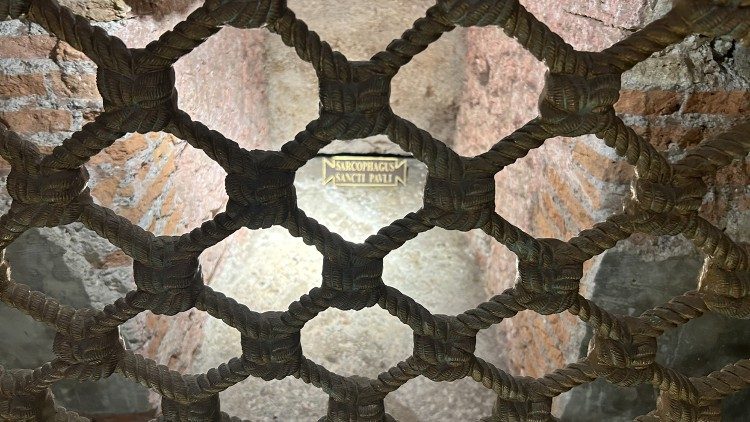
Early 2000s. Interest in the figure of Paul of Tarsus revives. Sensational discoveries bring to light, first, the oldest portrait of the Apostle of the Gentiles in the Roman catacombs of Santa Thecla and, then, a crude marble sarcophagus under the papal altar of the basilica that dates back to the author of the thirteen epistles of the New Testament.
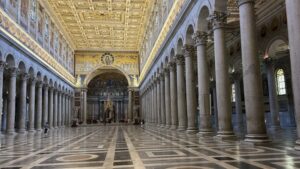
Scientific recognition
The confirmation was given with deep emotion on June 29, 2009, during the first eve of the closing of the Pauline Year, by Benedict XVI. On that occasion, the then Pontiff announced the results of the meticulous scientific analysis carried out on the tomb two thousand years after Paul’s birth: a special probe introduced into the sarcophagus revealed remains of a precious linen fabric dyed purple, laminated with pure gold, a blue fabric with linen filaments, red incense grains, and protein and calcareous substances. Very small bone fragments were also found.The latter, subjected to carbon 14 examination by experts who were unaware of their origin, date back to a person who lived between the 1st and 2nd centuries. “This seems to confirm the unanimous and indisputable tradition that these are the mortal remains of the apostle Paul,” commented Benedict XVI with concern.
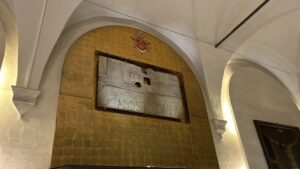
A grave never opened
Fifteen years after that announcement, we went to the tomb accompanied by Father Ludovico Torrisi, master of novices at the abbey of Saint Paul Outside the Walls, ruled since the 8th century by Benedictine monks. “The tomb has never been opened,” he explains, “because the vibrations to remove the lid, the contact with light and oxygen could destroy, disintegrate, what was left of Paul’s body.”
At the foot of the altar, under the wonderful ciborium made in 1285 by the famous sculptor Arnolfo di Cambio, the stones of the sarcophagus, brought to light in 2006 by researchers, are visible. A flame burns continuously, day and night, indicating the sacred nature of the place. Next to it is clearly visible a bronze and glass urn containing the chain of the Apostle’s Roman imprisonment, present in the basilica since the 4th century and carried in procession into the chamber every June 29, the feast of Saints Peter and Pablo
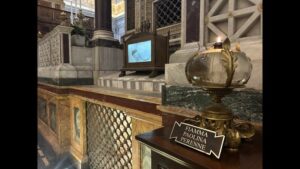
Through a grate you can see, below ground level, a marble slab made up of two pieces: it measures 2.12 x 1.27 meters. The inscription PAULO APOSTOLO MART appears on it and it has three holes: one round and two square. It dates back to the 4th-5th centuries and testifies to the cult that developed in the place from the beginning, even before a church was built. The holes had the function of obtaining contact relics, that is, strips of cloth that were inserted until they touched the tomb.
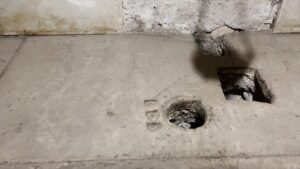
Extramural martyrdom
“The beheading of Saint Paul – continues Father Ludovico Torrisi – took place very close to the burial place. About four kilometers from the Basilica, in Acque Salvie, where the Abbey of the Three Fountains stands today. There Paul was taken from the Mamertine prison, where he was imprisoned. Historians have not yet understood why his martyrdom took place there. He was beheaded outside the Aurelian walls, in a place with an unhealthy air, near the Via Ostiense, between the years 65 and 67. under Emperor Nero.
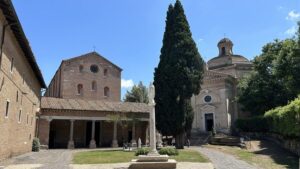
The Three Sources
His head fell to the ground three times and, according to tradition, at those three points three springs miraculously emerged: the first hot, the second warm and the third cold. On the avenue that borders the Trappist abbey, a pavement similar to those of ancient Rome has recently been reconstructed to evoke the path taken by the Saint before his execution. A marble inscription on the façade of the church of Saint Paul of the Martyrdom, built in the 5th century, renovated in 1599 by the architect Giacomo Della Porta, and which is part of the abbey complex, reads: “S. Pauli Apostoli martyrii locus ubi three sources mirabiliter eruperunt”. Inside the temple, three aedicules are clearly visible, built on each of the fountains aligned at the same distance, but at different levels. Since 1950, due to urbanization and the resulting contamination of the water table, the flow of water has been closed and its distribution to the faithful has ceased.
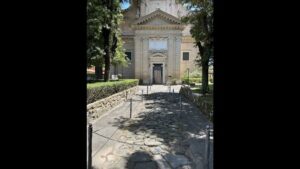
The sword
Imprisoned by the Jews, Paul had arrived in Rome in 61 to be tried there as a Roman citizen. Born a Jew with the name Saul, he enjoyed Roman citizenship like all the inhabitants of Tarsus, his city of origin, in Cilicia, south of modern-day Turkey. After moving to Jerusalem, he became a trusted man of the Sanhedrin and later a fierce persecutor of Christians. On the road to Damascus, in the year 36, his conversion took place.
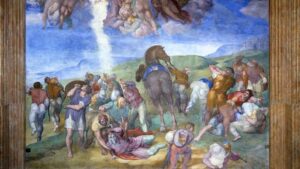
“Saint Paul – points out Father Ludovico – is represented with a sword to indicate how he defended the Word of God. To defend the Gospel he died by the sword with an atrocious death, like a brave combatant.”
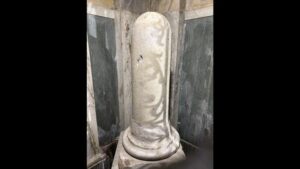
The heads of Peter and Paul
“It is said that after the beheading a Roman, Christian matron took charge of the body, placed it in a sarcophagus and buried it on the Via Ostiense,” adds Father Torrisi. According to the stories that have come down to us, this woman was called Lucina: three kilometers from the Acque Salvie there was a burial area within a pagan cemetery that had about 5,000 tombs. Excavations have confirmed the existence of this necropolis with niches and graves for the poor and freed slaves. Paul’s head was later found and preserved on the ciborium of the Basilica of Saint John Lateran along with that of Peter, buried in the Vatican Grottoes. According to the Roman Martyrology, both were murdered on the same day.
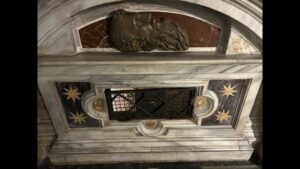
Their mortal remains are also united because during the persecutions both were sheltered inside the Catacombs of San Sebastián. This is attested to by the graffiti and votive offerings found at the archaeological site of the Appian Way. Subsequently, the remains of the two patron saints of Rome were returned to their original graves.
At the origins of the Church of Rome
The place of Paul’s burial immediately became a place of pilgrimage for the faithful, who came there to pray and, in homage to the Saint, built a cella memoriae. From the first years, numerous baptized people decided to be buried in the surroundings and the necropolis gradually went from pagan to Christian.
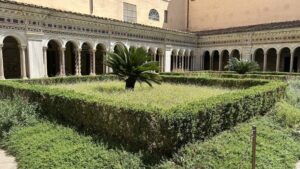
“Many chose to place their tombs near that of the Apostle,” recalls the Benedictine abbot, showing us the numerous epigraphs in Latin, Greek and Hebrew placed on the walls of the cloister of the abbey of Saint Paul Outside the Walls, designed and decorated by Pietro Vassalletto.
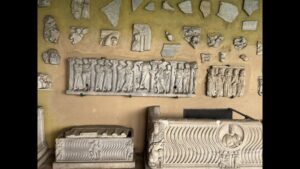
“During the various reconstruction works, excavations or reinforcement of the foundations, numerous finds, pagan and Christian tombs, were found here. Probably, these were people of a certain social level. Roman Christianity was born in this same area.” Among the most valuable objects found in this area in 1838 is the Dogmatic Sarcophagus, from the 4th century, currently in the Vatican Museums.
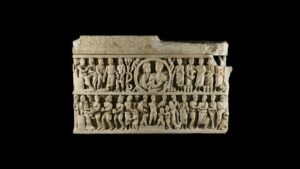
The three Basilicas
After sanctioning freedom of worship in the year 313 AD. With the Edict of Milan, Emperor Constantine wanted to worthily honor the memory of the Apostle of the People by monumentalizing the place of the first burial with a basilica in the year 324, the base of which is still visible today at the foot of the papal altar. The Saint’s body was first enclosed in a copper coffin. The temple, initially not very large, was later expanded by the emperors Theodosius, Arcadius and Valentinian II, thus becoming a very large basilica, with five naves, known as “Theodosian” or “of the three emperors”.
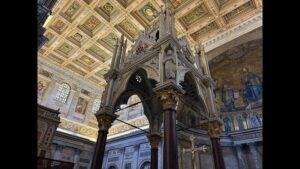
The masterpieces that survived the fire
Between the 12th and 13th centuries, great artistic personalities such as Pietro Cavallini, whose frescoes were unfortunately lost, and Arnolfo di Cambio, author of the ciborium that survived, along with the valuable candelabra for the paschal candle of Vassalletto, the devastating fire that destroyed the basilica Teodosiana in July 1823 in a single night.
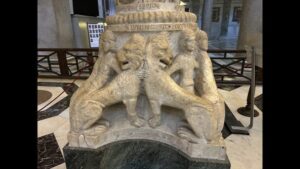
The fire and the reconstruction
The cause of the fire is unknown, which some attribute to a torch that may have been left unattended by workers repairing the roof. The day after the catastrophe, Romans flocked to see what remained of the church. The scene was desolate and heartbreaking. An exceptional witness, the French writer Stendhal described it as “one of the most surprising spectacles” he had ever seen: “I had an impression of severe beauty, as sad as Mozart’s music. The painful and terrible vestiges of the catastrophe were still alive. “The church was still packed with black, smoking and half-burned beams; the shafts of the columns, broken along their entire length, threatened to fall at every moment.”
On January 25, 1825, with the encyclical “Ad plurimas”, Leo and consecrated by Pius IX on December 10, 1854. In Saint Paul Outside the Walls, the most impressive work of the Church of Rome in the 19th century came to life in those years. The Basilica that emerged is exactly what we see today.
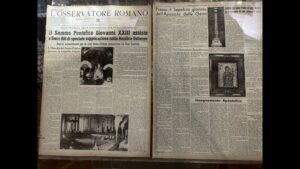
Saint Paul and the people everywhere
Not only Catholics, but the entire world responded en masse to the call of Leo XII: blocks of malachite and lapis lazuli were donated by Tsar Nicholas I, as well as columns and windows of the best alabaster from King Fouad I of Egypt. Paul of Tarsus confirmed himself as a universal reference point for both believers and Gentiles. Evocative of the chorus of people gathered around this giant of Christianity are the marble panels on the walls of the apse on which are engraved the names of the numerous cardinals and bishops present on the day of the consecration. They were in Rome for the proclamation of the Dogma of the Immaculate Conception. They celebrated it together with the Successor of Peter, symbolically under the gaze of all the Popes in history portrayed in mosaic in the large medallions that decorate the halls of the Hall.
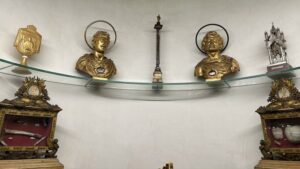
The apostle of Christian unity
As is well known, Paul’s apostolate extended from the Jews to all peoples: in Arabia, Asia Minor, Macedonia, Cyprus and Greece he founded numerous Christian communities. Emblematic of the adventures of the Apostle to the Gentiles is the relic of the staff used during his travels, preserved in the Museum of the Roman Basilica.
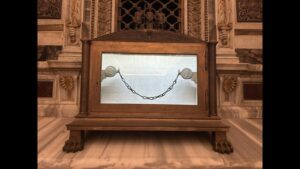
“Paul is venerated by the world population, Christian and non-Christian,” adds Father Ludovico Torrisi. He is a fundamental figure for the unity of Christians. Celebrations and ecumenical events take place in the basilica. Episodes and objects especially significant from this point of view are linked to this place. Here, on the Abbot’s floor, John XXIII announced to the cardinals, on January 25, 1959, his intention to convene the Second Vatican Ecumenical Council.
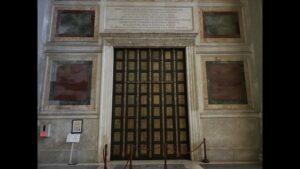
In 2006, Benedict XVI also fulfilled the wish of Saint John Paul II to gift two rings from the chains of the Apostle of the Gentiles to the Patriarch of Athens, Christodoulos.
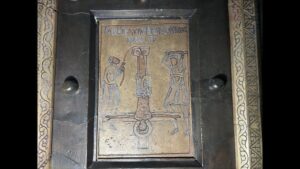
Saint Paul and the Jubilee
Finally, on the path towards full communion among Christians, the Holy Door of the Basilica of Saint Paul occupies a prominent place, which will open on January 5:
“It has a very important value. It was built in Constantinople and donated in 1070. Originally, it was located at the main entrance. A fire damaged it, reducing its size. Therefore, it was moved to a side entrance. In view of the Jubilee”, concludes Father Lodovico, “we hope that the faithful, pilgrims and tourists from all over the world will have here a beautiful experience of deep conversion and faith, of union and contact with the Lord through the testimony of the apostle Paul.”
Related
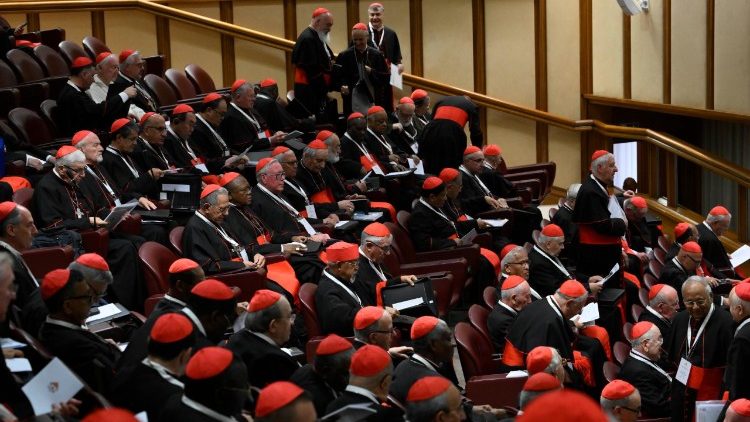
On the Road to the Conclave: The Church Prepares to Elect the New Pope on May 7
Alberto Ramírez
29 April, 2025
2 min
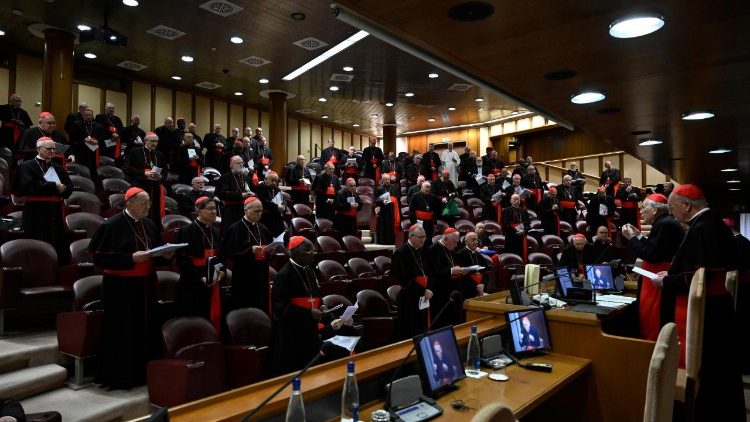
What are the Congregations before the Conclave?
Exaudi Staff
29 April, 2025
3 min
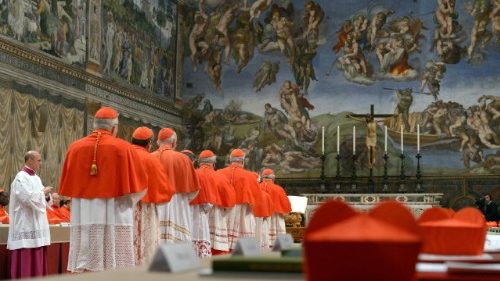
The Conclave will begin on May 7
Exaudi Staff
28 April, 2025
1 min

Cardinal Parolin at the Novendalia Mass: “Mercy leads us to the heart of faith”
Exaudi Staff
27 April, 2025
8 min
 (EN)
(EN)
 (ES)
(ES)
 (IT)
(IT)

